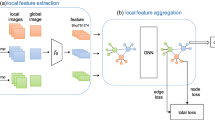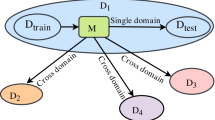Abstract
The graph neural network model has shown strong classification performance in few-shot learning (FSL) tasks in recent years. However, the existing methods have mainly participated in model training by extracting the single features of the samples as nodes. This method of constructing nodes ignores the multi-scale information contained in the samples to a certain extent and limits the expressiveness of node features. Therefore, we propose a multi-scale hierarchical node graph neural network (MsHN-GNN), which constructs hierarchical nodes bearing multi-scale information by deeply extracting structural features, global features, and local features of samples and enhances the representation ability of node features. At the same time, MsHN-GNN sorts the hierarchical relationship among sub-nodes through the block alignment module so that sub-nodes correspond one-to-one according to their own content attributes, which lays a foundation for updating multi-scale hierarchical nodes. In addition, we design a unique graph network update method according to the characteristics of hierarchical nodes. Through the multi-scale hierarchical node aggregation and edge aggregation modules, we realize the hierarchical information interaction among multiple sub-nodes so that the updated nodes and edge features have stronger information expression ability. Finally, to verify the effectiveness of the model, we conduct extensive experiments on miniImageNet, TiredImageNet, and CUB-200-2011 datasets. The experimental results show that MsHN-GNN outperforms other advanced few-shot learning methods with a graph structure in classification performance. In the above three datasets, the 5-way 1-shot experimental results achieved 68.32%, 72.56%, and 76.21%, respectively.







Similar content being viewed by others
Data Availability
The miniImageNet dataset is available at https://image-net.org/, Oriol Vinyals, Charles Blundell, Timothy Lillicrap, Daan Wierstra, 2016. Matching networks for one shot learning, in: Advances in Neural Information Processng Systems, pp. 3630-3638. [18] The TieredImageNet dataset is available at https://image-net.org/, Ren M, Triantafillou E, Ravi S, et al. Meta-learning for semi-supervised few-shot classification[J]. arXiv preprint arXiv:1803.00676, 2018. The CUB-200-2011 dataset is available at http://www.vision.caltech.edu/visipedia/CUB-200-2011.html, Catherine Wah, Steve Branson, Peter Welinder, Pietro Perona, and Serge Belongie. The caltech-ucsd birds- 200-2011 dataset. 2011. [32]
References
Tao T, Liu K, Wang L, Wu H (2015) Image recognition and analysis of intrauterine residues based on deep learning and semi-supervised learning. In: IEEE access, pp 162785–162799
Mane S, Mangale S (2018) Moving object detection and tracking using convolutional neural networks. In: 2018 second international conference on intelligent computing and control systems (ICICCS), pp 1809–1813
Tang J, Zhang F, Zhou Y, Yin Q, Hu W (2019) A fast inference networks for sar target few-shot learning based on improved siamese networks. In: IGARSS 2019–2019 IEEE international geoscience and remote sensing symposium, pp 1212–1215
Tyukin IY, Gorban AN, Alkhudaydi MH, Zhou Q (2021) Demystification of few-shot and one-shot learning. In: 2021 international joint conference on neural networks (IJCNN), pp 1–7
Yang Y, Li Y, Zhang R, Wang J, Miao Z (2020) Robust compare network for few-shot learning. In: 2020 IEEE access, pp 137966–137974
Ren M, Triantafillou E, Ravi S, Snell J, Swersky K, Tenenbaum JB (2018) Meta-learning for semi-supervised few-shot classification. arXiv:1803.00676
Nichol A, Achiam J, Schulman J (2018) On first-order meta-learning algorithms. arXiv:1803.02999
Finn C, Abbeel P, Levine S (2017) Model-agnostic meta-learning for fast adaptation of deep networks, in: In Proceedings of the 34th international conference on machine learning, pp 1126–1135
Wei T, Hou J, Feng R (2020) Fuzzy graph neural network for few-shot learning. In: 2020 international joint conference on neural networks (IJCNN), pp 1–8
Gao H, Xiao J, Yin Y, Liu T, Shi J (2022) A mutually supervised graph attention network for few-shot segmentation: the perspective of fully utilizing limited samples. In: IEEE transactions on neural networks and learning systems, pp 1–13
Lin G, Yang Y, Fan Y (2020) High-order structure preserving graph neural network for few-shot learning. arXiv:2005.14415v1
Tao G, Weichao L, Yanmin H, Yu L (2021) Graph-based prototypical network for few-shot learning. In: 2021 18th international computer conference on wavelet active media technology and information processing (ICCWAMTIP), pp 234–237
Liu Z, Xia Y, Zhang B (2020) Graph embedding relation network for few-shot learning. In: 2020 39th Chinese control conference (CCC), pp 7328–7334
Garcia V, Bruna J (2017) Few-shot learning with graph neural networks. arXiv:1711.04043
Kim J, Kim T, Kim S, Yoo CD (2019) Edge-labeling graph neural network for few-shot learning. In: 2019 IEEE/CVF conference on computer vision and pattern recognition (CVPR), pp 11–20
Yang L, Li L, Zhang Z, Zhou X (2020) Dpgn: distribution propagation graph network for few-shot learning. In: 2020 IEEE/CVF conference on computer vision and pattern recognition (CVPR), pp 13387–13396
Zhou B, Khosla A, Lapedriza A et al (2016) Learning deep features for discriminative localization. In: 2016 IEEE/CVF conference on computer vision and pattern recognition (CVPR), pp 2921–2929
Vinyals O, Blundell C, Lillicrap T, Wierstra D (2016) Matching networks for one shot learning. In: Advances in neural information processing systems, pp 3630–3638
Snell J, Swersky K, Zemel R (2017) Prototypical networks for few-shot learning. In: Advances in neural information processing systems, pp 4077–4087
Sung F, Yang Y, Zhang L, Xiang T, Torr PHS (2018) Learning to compare: relation network for few-shot learning. In: 2018 IEEE/CVF conference on computer vision and pattern recognition, pp 1199–1208
Dosovitskiy A, Beyer L et al (2021) An image is worth 16x16 words: transformers for image recognition at scale. International conference on learning representations
Yan Zhang, Yongsheng Sun et al (2021) MSEC: multi-scale erasure and confusion for fine-grained image classification. Neurocomputing 449:1–14
Kaur A, Chauhan APS, Aggarwal AK (2019) Machine learning based comparative analysis of methods for enhancer prediction in genomic data. In: 2019 international conference on intelligent communication and computational techniques (ICCT), Jaipur, India, pp 142–145, https://doi.org/10.1109/ICCT46177.2019.8969054.
Shervan F-E, Alsaffar MF (2023) Developing a tuned three-layer perceptron Fed with trained deep convolutional neural networks for cervical cancer diagnosis. Diagnostics 13(4):686–686. https://doi.org/10.3390/diagnostics13040686
Juan Xiao A, Stanley Anak Suab A et al (2023) Enhancing assessment of corn growth performance using unmanned aerial vehicles (UAVs) and deep learning. Measurement 214(2023):112764–112764 https://doi.org/10.1016/j.measurement.2023.112764
Rudenko A, Palmieri L et al (2020) Human motion trajectory prediction: a survey. Int J Robot Res 39(8):895–935. https://doi.org/10.1177/0278364920917446
Di Z, Zhou Y, Chen K, Chen Z (2021) A graph convolutional neural network model for trajectory prediction. Thirteenth international conference on graphics and image processing (ICGIP 2021). Kunming, China, vol 12083. https://doi.org/10.1117/12.2623385
Al-Sabri R, Gao JL et al (2023) Multi-view graph neural architecture search for biomedical entity and relation extraction. IEEE/ACM Trans Comput Biol Bioinform 20(2):1221–1233. https://doi.org/10.1109/TCBB.2022.3205113
Zhu L, Pan X et al (2022) A small sample recognition model for poisonous and edible mushrooms based on graph convolutional neural network. Comput Intell Neurosci 2276318. https://doi.org/10.1155/2022/2276318
Xiong C, Li W, Liu Y, Wang M (2021) Multi-dimensional edge features graph neural network on few-shot image classification. In: IEEE signal processing letters, pp 573–577
Chen C, Li K, Wei W, Zhou JT, Zeng Z (2022) Hierarchical graph neural networks for few-shot learning. In: IEEE transactions on circuits and systems for video technology, pp 240–252
Wah C, Branson S, Welinder P, Perona P, Belongie S (2011) The caltech-ucsd birds-200-2011 dataset. In: California institute of technology
Ravi S, Larochelle H (2017) Optimization as a model for few-shot learning. In: 2017 ICLR
Ye H-J, Hu H, Zhan D-C, Sha F (2018) Learning embedding adaptation for few-shot learning. arXiv:1812.03664
Mishra N, Rohaninejad M, Chen X, Abbeel P (2017) A simple neural attentive meta-learner. arXiv:1707.03141
Yoon SW, Seo J, Moon J (2019) TapNet: neural network augmented with task-adaptive projection for few-shot learning. In: Proc. 36th Int. Conf. Mach. Learn, pp 7115–7123
Lee K, Maji S, Ravichandran A, Soatto S (2019) Meta-learning with differentiable convex optimization. In: 2019 IEEE/CVF conference on computer vision and pattern recognition (CVPR), pp 10649–10657
Lifchitz Y, Avrithis Y, Picard S, Bursuc A (2019) Dense classification and implanting for few-shot learning. In: 2019 IEEE/CVF conference on computer vision and pattern recognition (CVPR), pp 9250–9259
Mallika G, Singh UJ, Kumar AA (2023) Neural style transfer for image steganography and destylization with supervised image to image translation. Multimed Tools Appl 82(2023):6271–6288. https://doi.org/10.1007/s11042-022-13596-3
Acknowledgements
This work was supported by Anhui Province Key Research and Development Program (2022k07020006), the central government guides local funds of Anhui provincial in 2021 (K120636001) and the University Synergy Innovation Program of Anhui Province(GXXT-2022-038).
Author information
Authors and Affiliations
Contributions
All authors contributed to the study conception and design. Material preparation, data collection and analysis were performed by [Yan Zhang], [Xudong Zhou], [Ke Wang], [Nian Wang] and [Zenghui Li]. The first draft of the manuscript was written by [Xudong Zhou] and all authors commented on previous versions of the manuscript. All authors read and approved the final manuscript.
Corresponding author
Ethics declarations
Ethics approval
This article does not contain any studies with human participants or animal performed by any of the authors.
Competing Interests
The authors declare that they have no conflict of interest.
Additional information
Publisher's Note
Springer Nature remains neutral with regard to jurisdictional claims in published maps and institutional affiliations.
Rights and permissions
Springer Nature or its licensor (e.g. a society or other partner) holds exclusive rights to this article under a publishing agreement with the author(s) or other rightsholder(s); author self-archiving of the accepted manuscript version of this article is solely governed by the terms of such publishing agreement and applicable law.
About this article
Cite this article
Zhang, Y., Zhou, X., Wang, K. et al. A multi-scale hierarchical node graph neural network for few-shot learning. Multimed Tools Appl (2023). https://doi.org/10.1007/s11042-023-17059-1
Received:
Revised:
Accepted:
Published:
DOI: https://doi.org/10.1007/s11042-023-17059-1




